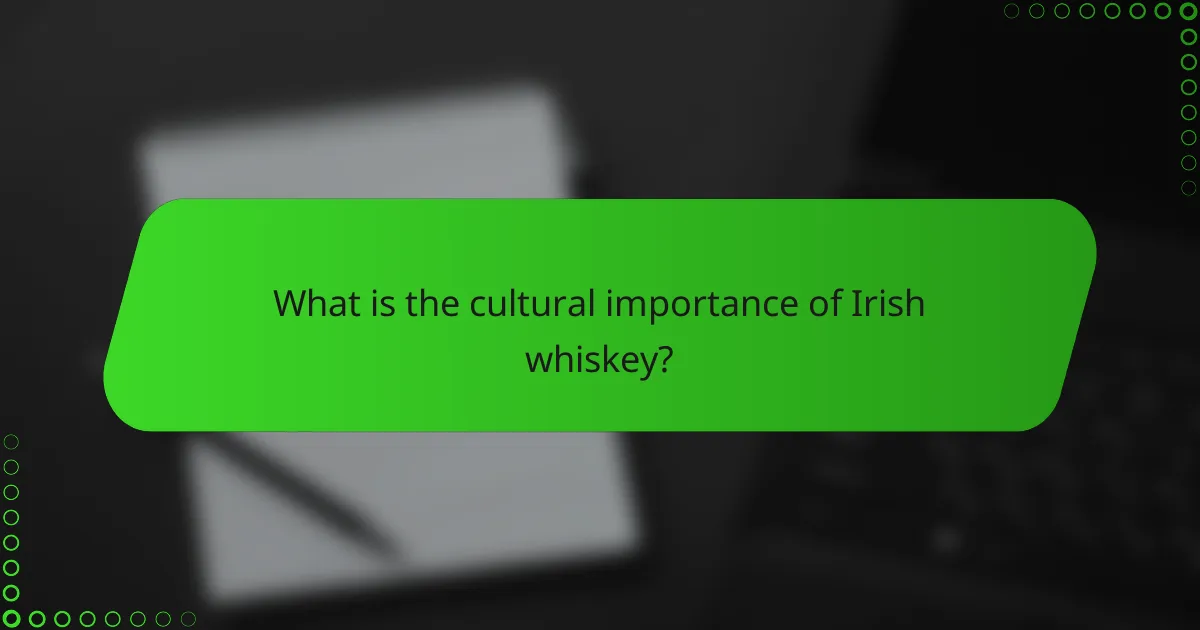Irish whiskey is a distilled spirit with a history that dates back to the 12th century, first recorded in the Annals of the Four Masters as “uisce beatha,” or “water of life.” The article explores the evolution of Irish whiskey production, highlighting the prominence of pot still whiskey in the 17th and 18th centuries, and the challenges faced in the 19th and 20th centuries, including competition from Scotch whisky and Prohibition in the United States. It details the distinct distillation methods—pot still and column still—that contribute to the whiskey’s smooth and approachable flavor profile, characterized by notes of honey, vanilla, and fruit. Additionally, the cultural significance of Irish whiskey is examined, illustrating its role in national identity, social gatherings, and global appreciation for Irish craftsmanship.

What is the history of Irish whiskey?
Irish whiskey has a rich history that dates back to the 12th century. The earliest records of whiskey production in Ireland appear in the Annals of the Four Masters. These texts mention the distillation of a spirit called “uisce beatha,” meaning “water of life.” By the 17th century, Irish whiskey gained popularity, particularly in the form of pot still whiskey.
In the 18th century, the Irish whiskey industry flourished, with over 1,000 distilleries operating at its peak. However, the 19th century brought challenges, including the introduction of Scotch whisky and trade restrictions. These factors led to a decline in Irish whiskey production.
The 20th century saw further struggles, including Prohibition in the United States and the Irish Civil War. Despite these setbacks, a revival began in the late 20th century. Today, Irish whiskey is celebrated globally for its smoothness and unique flavor profiles.
How did the distillation of Irish whiskey begin?
The distillation of Irish whiskey began in the early medieval period. Monks in Ireland were among the first to distill spirits. They used pot stills to create a spirit from fermented grains. This process evolved over centuries. By the 12th century, written records mention the production of whiskey. The word “uisce beatha,” meaning “water of life,” is derived from Gaelic. This term reflects the cultural significance of whiskey in Irish society. The earliest documented distillery in Ireland was established in 1608 at Bushmills. This marked the beginning of commercial whiskey production in the region.
What were the early methods of distillation used in Ireland?
The early methods of distillation used in Ireland primarily involved pot stills. Pot stills are traditional distillation apparatus made of copper. These stills allowed for the separation of alcohol from fermented grain mash. The process typically began with mashing barley and fermenting it with yeast. The fermented mash was then heated in the pot still. The alcohol vapor collected and condensed into liquid form. This method produced a spirit known as “uisge beatha,” meaning “water of life.” Historical records indicate that distillation in Ireland dates back to at least the 12th century.
How did historical events influence the development of Irish whiskey?
Historical events significantly shaped the development of Irish whiskey. The introduction of distillation methods in the 12th century laid the foundation for whiskey production. The 17th century saw the establishment of legal distilleries, driven by English taxation policies. This led to a proliferation of distilleries across Ireland. The Irish War of Independence and subsequent Civil War disrupted production and exports. Prohibition in the United States further impacted the industry, reducing demand for Irish whiskey. In the late 20th century, a revival occurred due to global interest in craft spirits. Today, Irish whiskey reflects a rich history influenced by various socio-political events.
What are the key milestones in the evolution of Irish whiskey?
Irish whiskey has evolved through several key milestones. The earliest records date back to the 12th century, when monks began distilling spirits in Ireland. In the 17th century, Irish whiskey gained international recognition, becoming a popular export. The introduction of pot still distillation in the 18th century enhanced its flavor profile. The establishment of the Old Bushmills Distillery in 1608 marked the first licensed distillery. The Irish Whiskey Act of 1980 standardized production methods, ensuring quality. The 20th century saw a decline due to Prohibition and competition from Scotch whisky. However, the revival in the late 20th century led to a resurgence of interest and new distilleries. Today, Irish whiskey is celebrated globally for its smoothness and diversity.
Which notable distilleries played a role in shaping Irish whiskey?
Midleton Distillery, Jameson, and Bushmills are notable distilleries that shaped Irish whiskey. Midleton Distillery, established in 1825, produces several renowned brands, including Jameson and Redbreast. Jameson, founded by John Jameson in 1780, is one of the best-selling Irish whiskeys globally. Bushmills, established in 1608, is recognized as one of the oldest distilleries in the world. These distilleries contributed significantly to the production methods and global reputation of Irish whiskey. Their innovations in distillation and aging processes have influenced the flavor profiles that characterize Irish whiskey today.
How did the global market impact Irish whiskey production?
The global market significantly impacted Irish whiskey production by increasing demand and expanding export opportunities. This surge began in the late 20th century as international interest in premium spirits grew. Irish whiskey’s unique flavor profile and heritage attracted consumers worldwide. In 2019, Irish whiskey exports reached over 12 million cases, marking a 300% increase since 2010. This demand led to the reopening of historic distilleries and the establishment of new ones. The global market also encouraged innovation in production methods and flavor variations. Consequently, the industry adapted to meet consumer preferences while maintaining traditional craftsmanship.

What are the different distillation methods used for Irish whiskey?
The different distillation methods used for Irish whiskey are pot still distillation and column still distillation. Pot still distillation is traditional and often used for single malt and pot still whiskeys. This method involves heating the mash in a pot still, allowing for a rich and complex flavor profile. Column still distillation, also known as continuous distillation, is more efficient and used for grain whiskeys. This method allows for higher alcohol content and a lighter flavor. Both methods contribute uniquely to the character of Irish whiskey.
How does pot still distillation differ from column still distillation?
Pot still distillation involves batch processing and typically produces a richer, more complex spirit. This method uses a pot-shaped vessel, where the wash is heated and distilled in a single run. It is traditional in Irish whiskey production and allows for greater control over the flavor profile.
In contrast, column still distillation operates continuously and can produce a higher alcohol content. This method utilizes a tall column with multiple plates, allowing for repeated distillation without the need for separate batches. It is more efficient and often used in large-scale production.
The differences in these methods significantly affect the final product’s flavor and character. Pot still distillation emphasizes depth and complexity, while column still distillation focuses on purity and efficiency.
What are the advantages of pot still distillation for flavor?
Pot still distillation enhances flavor by allowing for a richer and more complex profile. This method retains more of the original ingredients’ characteristics. Pot stills have a wider shape, promoting greater interaction between the vapor and the copper. This interaction removes unwanted sulfur compounds, improving the overall taste. The process typically involves multiple distillations, which concentrate flavors further. Traditional Irish whiskey often uses pot still distillation, resulting in a distinctive mouthfeel. This technique contributes to the signature spiciness and fruitiness found in many Irish whiskeys. Thus, pot still distillation is essential for creating unique flavor profiles in whiskey.
How does column still distillation affect the alcohol content?
Column still distillation increases the alcohol content of the final product. This method allows for continuous distillation, which results in higher alcohol concentrations. Column stills, also known as patent stills, use a series of plates to separate alcohol from other components efficiently. The process enables the extraction of higher purity spirits compared to pot stills. Typically, column still distillation can achieve alcohol levels of 90% or more. This efficiency is due to the repeated vaporization and condensation within the column. The design of the column allows for better separation of ethanol from impurities. Therefore, column still distillation significantly enhances the overall alcohol content in spirits like Irish whiskey.
What unique techniques are employed in Irish whiskey production?
Irish whiskey production employs unique techniques such as triple distillation, pot still distillation, and the use of unmalted barley. Triple distillation results in a smoother spirit with a lighter flavor profile. Pot still distillation allows for a fuller-bodied whiskey, combining both malted and unmalted barley. The inclusion of unmalted barley contributes to the whiskey’s distinctive taste and texture. These methods are rooted in tradition and are essential to the character of Irish whiskey. Historically, these techniques have set Irish whiskey apart from other whiskeys, such as Scotch, which typically uses double distillation. The combination of these methods creates a unique flavor profile that is celebrated worldwide.
How does the use of unmalted barley influence flavor profiles?
The use of unmalted barley influences flavor profiles by imparting a distinct earthiness and nuttiness. This barley type contributes to a lighter, more floral character in the whiskey. Unmalted barley also enhances the complexity of flavors, often resulting in a creamier mouthfeel. Additionally, it can introduce subtle grassy notes and a hint of sweetness. Historical practices in Irish whiskey production often relied on unmalted barley, shaping regional flavor preferences. The traditional use of unmalted barley is a hallmark of many Irish distilleries, contributing to their unique identities.
What role does triple distillation play in Irish whiskey’s character?
Triple distillation is a key process that shapes the character of Irish whiskey. This method results in a smoother and lighter spirit compared to those produced by double distillation. The triple distillation process involves three rounds of distillation, which enhances purity and reduces impurities. As a result, the whiskey often exhibits a softer mouthfeel and a more refined flavor profile.
Historically, Irish distillers adopted this technique to differentiate their whiskey from Scottish counterparts. The practice became prominent in the 19th century, contributing to the unique identity of Irish whiskey. Many well-known brands, such as Jameson and Bushmills, utilize triple distillation, reinforcing its significance in the industry. This method also allows for a greater retention of the natural flavors of the grains used, leading to a distinctively smooth and approachable spirit.

What are the flavor profiles of Irish whiskey?
Irish whiskey typically features a smooth, light, and approachable flavor profile. Common tasting notes include honey, vanilla, and fruit, often with a hint of spice. The use of malted and unmalted barley contributes to its unique taste. Some varieties exhibit floral and citrus undertones. The triple distillation process generally results in a cleaner finish. Aging in various cask types, such as bourbon or sherry, adds complexity. Notable brands like Jameson and Bushmills illustrate these flavor characteristics. Overall, Irish whiskey is known for its balanced and mild profile, appealing to a wide range of palates.
What are the common taste characteristics of Irish whiskey?
Irish whiskey commonly exhibits a smooth, light, and slightly sweet taste profile. This smoothness is often attributed to triple distillation, which is typical in Irish whiskey production. The flavor profile frequently includes notes of honey, vanilla, and fruit, such as apple or pear. Additionally, a hint of spice can be present, often from the use of sherry casks during aging. The finish is generally clean and mellow. These characteristics differentiate Irish whiskey from other types, such as Scotch, which tends to be more robust and smoky.
How do the ingredients affect the flavor of Irish whiskey?
The ingredients significantly influence the flavor of Irish whiskey. The base ingredient, malted barley, contributes sweetness and a rich, nutty profile. Unmalted barley adds a lighter, grassy note. Water quality affects the smoothness and overall mouthfeel. Yeast plays a crucial role in fermentation, producing fruity esters and complex flavors. The distillation process, often triple-distilled, enhances smoothness and reduces harshness. Aging in wooden casks introduces flavors from the wood, such as vanilla, caramel, and spice. The combination of these elements creates the unique flavor profile characteristic of Irish whiskey.
What impact do aging processes have on whiskey flavor?
Aging processes significantly impact whiskey flavor. During aging, whiskey interacts with the wood of the barrel. This interaction leads to the extraction of compounds from the wood. These compounds contribute flavors such as vanilla, caramel, and spice.
The length of aging also affects flavor complexity. Longer aging typically results in a smoother and richer profile. However, over-aging can lead to excessive tannins and bitterness.
Environmental factors like temperature and humidity further influence the aging process. These factors affect the rate of evaporation and absorption of flavors.
Research shows that whiskey aged in charred barrels develops a more pronounced flavor profile. The charring process caramelizes the sugars in the wood. This adds depth and character to the whiskey.
Overall, aging is crucial in developing the unique flavor profiles of different whiskeys.
How do regional differences influence the flavor of Irish whiskey?
Regional differences significantly influence the flavor of Irish whiskey. The variations in climate, soil, and water sources across Ireland affect the ingredients used. For instance, whiskeys from the coastal regions often have a maritime influence, imparting briny notes. In contrast, whiskeys from inland areas may present more earthy or fruity flavors due to different grain sources.
The distillation methods also vary regionally, with some areas favoring pot stills and others using column stills. This choice impacts the texture and complexity of the whiskey. Additionally, aging conditions differ, as some regions have more humidity, which can enhance the maturation process.
Specific examples include the peated whiskeys from Connemara, which offer a smoky flavor profile that contrasts with the smoother, triple-distilled varieties from Dublin. These regional characteristics create a diverse spectrum of flavors in Irish whiskey, reflecting the unique terroir of each area.
What flavors are distinctive to whiskey from different Irish regions?
Whiskey from different Irish regions exhibits distinctive flavors. In the northern region, particularly from Antrim, whiskeys often have a peaty, smoky flavor profile. This is influenced by the use of peat in the malting process. In contrast, whiskeys from the midlands, like those from Tullamore, are known for their smoothness and light fruitiness. They often feature notes of honey and vanilla. The southern region, especially Cork, showcases richer, spicier flavors with hints of dried fruits and nuts. Finally, whiskeys from the west, such as those from Connemara, are recognized for their complex, herbal notes and a touch of brine, reflecting the coastal environment. Each region’s unique climate and production methods significantly contribute to these flavor profiles.
How do local water sources contribute to flavor variations?
Local water sources significantly contribute to flavor variations in Irish whiskey. The mineral content and pH levels of water can influence the fermentation process. Water from different regions contains varying amounts of minerals like calcium and magnesium. These minerals can affect yeast activity, impacting the overall flavor profile. Additionally, the purity of the water can enhance the smoothness of the whiskey. For example, soft water is often preferred for producing lighter, fruitier flavors. In contrast, hard water can produce richer, more robust flavors. Historical records show that distilleries often select water sources based on their unique characteristics to achieve desired flavor outcomes.

What is the cultural importance of Irish whiskey?
Irish whiskey holds significant cultural importance as a symbol of national identity and heritage. It is deeply intertwined with Ireland’s history, reflecting the country’s agricultural practices and craftsmanship. The production of Irish whiskey dates back to the 12th century, showcasing its long-standing tradition.
Irish whiskey is often associated with social gatherings and celebrations, serving as a medium for storytelling and connection. It plays a role in various cultural rituals and events, such as St. Patrick’s Day, where it is featured prominently.
The global popularity of Irish whiskey has contributed to the promotion of Irish culture worldwide. Distilleries often emphasize traditional methods, enhancing the appreciation for Irish craftsmanship. Furthermore, awards and recognitions in international spirits competitions highlight its quality and significance.
Overall, Irish whiskey is not just a beverage; it embodies the spirit, resilience, and culture of Ireland.
How has Irish whiskey shaped Irish culture and identity?
Irish whiskey has significantly shaped Irish culture and identity. Its production dates back to the 12th century, making it a historical staple. The drink is intertwined with Irish traditions, often featured in celebrations and social gatherings. Irish whiskey is also a symbol of national pride, especially during the 19th-century global expansion. The Irish whiskey industry faced challenges, including prohibition and competition, yet it has seen a resurgence since the 2000s. This revival has fostered a renewed interest in Irish heritage and craftsmanship. Today, Irish whiskey is recognized worldwide, enhancing Ireland’s cultural footprint. Its unique flavors reflect the diverse landscapes of Ireland, reinforcing a connection to the land and its people.
What role does Irish whiskey play in traditional Irish celebrations?
Irish whiskey is a central element in traditional Irish celebrations. It is often used in toasts during significant life events such as weddings and birthdays. The drink symbolizes hospitality and friendship, fostering a sense of community among participants. Additionally, Irish whiskey features prominently in festive gatherings, including St. Patrick’s Day and Christmas. Historical records indicate that whiskey has been part of Irish culture for centuries, enhancing its significance in celebrations. The rich flavors of Irish whiskey also contribute to the enjoyment of traditional Irish music and dance during these occasions. Overall, it serves both as a beverage and a cultural symbol, reinforcing social bonds and traditions.
How has Irish whiskey been represented in literature and art?
Irish whiskey has been represented in literature and art as a symbol of cultural identity and tradition. Many Irish poets and writers, such as W.B. Yeats and James Joyce, have referenced whiskey in their works. These references often highlight themes of camaraderie and celebration. In visual art, Irish whiskey is depicted in paintings and advertisements that evoke a sense of heritage. The imagery often includes traditional Irish landscapes and social gatherings. This representation reinforces the whiskey’s role in Irish social life. Historical texts and artworks showcase whiskey as a source of national pride. The portrayal of Irish whiskey continues to evolve, reflecting contemporary cultural narratives.
What are the modern trends in Irish whiskey culture?
Modern trends in Irish whiskey culture include a significant rise in craft distilling. Many new distilleries have emerged, focusing on artisanal production methods. This shift emphasizes quality over quantity. There is also a growing interest in unique flavor profiles. Distillers experiment with various cask finishes and ingredients. Sustainability practices are becoming more common in production. Consumers increasingly prefer locally sourced and organic ingredients. Whiskey tourism is thriving, with distillery tours and tastings gaining popularity. The global market for Irish whiskey is expanding, with exports reaching record levels. According to the Irish Whiskey Association, exports surpassed 12 million cases in 2020, highlighting the international appeal.
How are craft distilleries influencing the Irish whiskey scene?
Craft distilleries are significantly influencing the Irish whiskey scene by introducing innovation and diversity. They are experimenting with unique ingredients and distillation techniques. This has led to a broader range of flavor profiles. For example, many craft distilleries use local grains and innovative cask finishes. These practices enhance the overall quality and complexity of Irish whiskey. Additionally, craft distilleries are reviving traditional methods. This includes pot still distillation, which adds authenticity to their products. The rise of these distilleries also promotes local economies. They attract tourism and create jobs in rural areas. Overall, craft distilleries are reshaping the landscape of Irish whiskey through creativity and tradition.
What impact does tourism have on the appreciation of Irish whiskey?
Tourism significantly enhances the appreciation of Irish whiskey. Visitors to Ireland often engage in distillery tours and tastings. These experiences educate tourists about whiskey production and its cultural heritage. Increased exposure leads to a greater understanding of flavor profiles and distillation methods. As tourists share their experiences, they contribute to a global appreciation of Irish whiskey. According to the Irish Whiskey Association, tourism has driven a 300% increase in distillery visits from 2013 to 2019. This surge has fostered a deeper connection between consumers and the product. Ultimately, tourism serves as a catalyst for the growth of the Irish whiskey market.
What are some tips for enjoying Irish whiskey?
To enjoy Irish whiskey, start by selecting a quality brand known for its smoothness. Popular options include Jameson and Redbreast, which are widely respected. Next, serve it neat in a whiskey glass to appreciate the aroma and color. Swirling the whiskey gently releases its scents, enhancing the tasting experience. Take small sips to savor the flavors, noting the sweetness and spiciness characteristic of Irish whiskey. Pair it with complementary foods, such as dark chocolate or aged cheese, to elevate the tasting. Finally, consider exploring different expressions, as aging and cask types influence flavor profiles significantly.
How should Irish whiskey be served for optimal flavor?
Irish whiskey should be served neat or with a splash of water for optimal flavor. Serving it neat allows the drinker to fully appreciate its complex aromas and flavors. Adding a small amount of water can enhance the whiskey’s taste by releasing additional aromatic compounds. The ideal serving temperature is slightly below room temperature, around 60-65°F (15-18°C). This temperature range helps to highlight the whiskey’s character without masking it. Using a tulip-shaped glass can concentrate the aromas, enhancing the overall tasting experience. Historical practices also suggest that serving whiskey in this manner aligns with traditional Irish customs, emphasizing its rich heritage.
What are the best food pairings for Irish whiskey?
The best food pairings for Irish whiskey include rich meats, aged cheeses, and dark chocolate. These foods complement the smooth and slightly sweet flavor profile of Irish whiskey. For instance, grilled lamb and beef dishes enhance the whiskey’s complexity. Aged cheeses like cheddar or Gouda bring out the whiskey’s creamy notes. Dark chocolate, especially with high cocoa content, balances the whiskey’s sweetness. Seafood, particularly smoked salmon, also pairs well due to its rich flavors. Spicy foods can contrast nicely with the smoothness of Irish whiskey. Each pairing enhances the tasting experience, making it more enjoyable.
The main entity of this article is Irish whiskey, encompassing its history, distillation methods, flavor profiles, and cultural significance. The article traces the origins of Irish whiskey back to the 12th century, highlighting key milestones such as the establishment of distilleries and the impact of historical events on production. It explores various distillation techniques, including pot still and column still methods, and their influence on flavor characteristics. Additionally, the article examines how regional differences, aging processes, and the use of ingredients contribute to the diverse flavor profiles of Irish whiskey. Finally, it discusses the cultural importance of Irish whiskey in social rituals and its role in shaping national identity.


